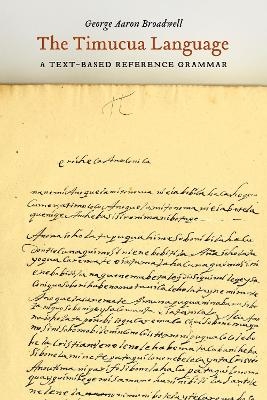
The Timucua Language
University of Nebraska Press (Verlag)
978-1-4962-3778-1 (ISBN)
- Noch nicht erschienen (ca. Dezember 2024)
- Versandkostenfrei innerhalb Deutschlands
- Auch auf Rechnung
- Verfügbarkeit in der Filiale vor Ort prüfen
- Artikel merken
The Timucua Language is a comprehensive reference grammar of Timucua, the Native language of much of northern Florida during the Spanish colonial period. Though the Timucua language is no longer spoken, written Timucua was extensively used as a medium of Franciscan evangelism in the seventeenth century; indeed, the Timucua catechisms from 1612 are the earliest written records in any Native language of the land that is now the United States. Two secular letters in the language also survive from that period. As a whole, the Timucua written corpus gives us incomparable insight into the Indigenous culture and history of early Florida.
This grammar is based on a thorough study of the extant printed and handwritten documents and on careful philological and comparative analysis of the corpus. Because the content of printed Timucua material often varies considerably from the Spanish text printed in parallel with it, careful study of Timucua grammar enables linguists, anthropologists, and historians to begin to read these critical texts in Florida and southeastern U.S. history.
George Aaron Broadwell is the Elling Eide Professor of Anthropology at the University of Florida. He won the 2023 Victor Golla Prize from the Society for the Study of the Indigenous Languages of the Americas and is the author of A Choctaw Reference Grammar (Nebraska, 2006).
List of Illustrations
List of Tables
Acknowledgments
List of Abbreviations
Part 1. Historical background and literature overview
1 About the language
1.1 History
1.2 Dialectal variation
1.3 Previous research and genetic affiliations
2 The corpus and citation conventions
3 Interpreting the corpus
3.1 Documents written by native speakers
3.2 Pareja’s Arte
3.3 Orthographic and lexical diversity
3.3.1 Lexical choice
3.3.2 Labialization
3.3.2.1 Variation in the postposition beta
3.3.2.2 Variation in the irrealis suffix -haue
4 Grammar overview
4.1 Phonological typology
4.2 Morphological typology
4.3 Word order and simple verb inflection
4.4 Simple nouns and noun phrases
4.5 Simple postpositional phrases
4.6 More complex verb agreement
4.7 Linking clauses together
4.8 Question particles and question words
4.9 Typological classification
Part 2 Phonology
5 Phonological inventory and orthography
5.1 Consonants
5.1.1 The interpretation of in Timucua
5.1.2 Bilabial glide [w]
5.1.3 /hw/
5.1.4 Labiodental or bilabial fricatives
5.1.5 Velar nasal
5.1.6 /r/ as a tap
5.1.7 Lack of geminate consonants
5.1.8 Spellings in loanwords
5.2 Vowels
5.2.1 Vowel quality
5.2.2 Vowel length
5.2.3 Vowel nasalization
5.2.4 Diphthongs
5.3 Syllables
5.4 Words with +vowel sequences
5.5 Distributional skewing
5.6 Stress
5.6.1 Pareja’s description of stress
5.6.2 Accent marking in the corpus
5.6.2.1 Penult stress before -te ‘contrastive’
5.6.2.2 Penult stress before -co ‘alternative’
5.6.2.3 Penultimate stress before -ta participial
6 Major phonological and morphophonological processes
6.1 Vowel coalescence and deletion
6.1.1 Vowel coalescence and prefixes
6.1.2 Vowel-deleting suffixes
6.1.3 Vowel deletion in compounds
6.1.4 Vowel syncope before -ta and -te
6.2 Round vowel harmony in roots
6.2.1 Height harmony in round vowels
6.2.1.1 Suffixes that show vowel harmony
6.2.1.2 Suffixes that do not show vowel harmony
6.3 Vowel lowering
6.3.1 Lowering after labial consonants
6.3.2 Lowering before -la ‘declarative’
6.3.2.1 Lowering in verb roots
6.3.3 Lowering in other environments
6.4 Front vowel lowering
6.4.1 Lowering of -i final affixes
6.5 Voicing after nasals
6.6 Reduplication
6.6.1 Full reduplication
6.6.2 Partial reduplication
6.7 Phonology of loanwords
Part 3. Morphosyntax
7 Nouns
7.1 Derivational processes
7.1.1 Agent nominalization with -siba
7.1.1.1 Introduction
7.1.1.2 The relationship of -siba ‘agent nominalization’ and -si ‘benefactive’
7.1.2 Nominalizations with -te . . . ma
7.1.2.1 Introduction
7.1.2.2 Semantics of nominalizations with -te . . . ma
7.1.3 Nominalizations with -no
7.2 Compounds
7.2.1 Head-final N+N compounds
7.2.2 Head-initial N+Adj compounds
7.2.3 Head-final N+V compounds
7.2.4 Noun+-nimi ‘all’
7.2.5 Other multiword expressions
7.3 Nominal inflectional morphology
7.3.1 Nominal inflectional suffix order
7.3.2 Possessive suffixes
7.3.2.1 First singular possessor -na
7.3.2.2 Second singular possessor -ye
7.3.2.3 Third possessor -mi
7.3.2.4 Alternate third possessor -miti ~ -mitota
7.3.2.5 First plural -mile and -nica
7.3.2.6 Second plural -yaqe
7.3.2.7 Respected second or third possessor -mitono
7.3.2.8 Rare possessive suffix -nchu
7.3.3 Noun plural
7.3.4 Nominal inflection of borrowed words
7.4 Lack of grammatical gender
8 Adjectives
9 Noun phrases
9.1 Order in noun phrases
9.2 Affixes attached to noun phrases
9.2.1 Predeterminers
9.2.1.1 Indefinite predeterminers -lete ~ -leta and -nco
9.2.1.2 -lehe ‘or’
9.2.1.3 Reflexive/emphatic -coco
9.2.2 Determiners
9.2.2.1 -michu ‘previous mention’
9.2.2.2 -co alternative
9.2.2.3 -leqe ‘additive focus’
9.2.3 Postdeterminers
9.2.3.1 Oblique affix -qua
9.2.3.2 Contrastive focus marker -te
9.2.3.3 Topic marker -no
9.2.4 Frequent combinations
9.2.4.1 Topic marking with -mano
9.2.4.2 Coordination with -mate
9.2.5 Mysteries
9.2.5.1 letani
9.2.5.2 qe
9.3 Prenominal determiners
9.3.1 Introduction
9.3.2 acu
9.3.3 caqi and naqi
9.3.4 Far demonstratives oqe and qeqi
9.4 Possession
9.4.1 Attributive possession
9.4.2 Lack of genitive case
9.4.3 Predicative possession
9.5 Definiteness
9.5.1 Definite and indefinite morphology
9.5.2 Cooccurrence of definite and indefinite morphology
9.5.3 Definite marking and possessives
9.5.4 Definite marking and proper nouns
10 Pronouns and other anaphoric elements
10.1 Personal pronouns
10.1.1 First- and second-person pronouns
10.1.2 Third-person pronouns
10.2 Demonstrative pronouns
10.3 Indefinite pronouns
10.4 Pro-verbs
11 Numbers and quantifiers
11.1 Quantifiers and other indicators of plurality
11.1.1 Alleged plurals
11.1.2 Collective nouns
11.1.3 Universal quantifiers and their equivalents
11.1.4 Each
11.2 Numbers
11.2.1 Cardinal numbers
11.2.2 Ordinal numbers
11.2.3 Verbal properties of numbers
12 Adverbs
12.1 Temporal adverbs
12.2 Discourse adverbs
12.3 Manner adverbs
12.4 Manner modification via reduplication
13 Postpositions and their equivalents
13.1 ofueno ‘over’, ‘concerning’, ‘after’
13.2 beta ‘oblique’
13.3 toro ‘without’
13.4 emoqua ‘against’, ‘in front of’
13.5 Other postposition-like words
14 Verbs: Morpheme order, derivation, suppletion, and incorporation
14.1 Verb structure and morpheme order
14.2 Deriving verbs
14.3 Verbal suppletion
14.4 Semiproductive derivation
14.4.1 Derived verbs with -timo
14.4.2 Derived verbs with -qua
14.4.3 Derived verbs with -chi
14.5 Incorporation
14.5.1 Identifying incorporation
14.5.2 Incorporation of the complement of the copula
14.5.3 Verbs with incorporation of cume ‘heart’
14.5.4 Incorporation of ano
14.5.5 Incorporated interrogatives
14.5.6 Alternation with nonincorporated structures
14.6 Incorporation of verbs
15 Verb agreement
15.1 Introduction
15.2 Agreement with third-person arguments
15.3 Ergative and absolutive agreement paradigms
15.3.1 Intransitive agreement
15.3.2 Transitives in default or unmarked tense
15.3.3 Interrogative agreement shift
15.3.4 Tense-based agreement shift
15.3.5 Allomorphic alternation in agreement
15.3.5.1 The form of the first ergative suffix -n
15.3.5.2 An apparent alternative first ergative suffix -na
15.3.5.3 Against an alternative with -la as first singular ergative
15.3.5.4 Alternations for second person
15.3.6 Transitives with applied arguments
15.4 Controversial issues
15.4.1 Arguments for the accusative-ergative split
15.4.2 Postposed second person: ergative vs. absolutive
15.4.3 Ergative agreement: preceded by default tense vs. participial suffix
15.5 Unresolved issues
15.5.1 Ergative agreement in intransitives
15.5.2 Ergative-absolutive alternation in reciprocals
16 Valency increase: Causatives and applicatives
16.1 Causatives
16.1.1 Regular causatives
16.1.2 Causatives and quantifiers
16.1.3 “Frozen” causatives
16.1.4 Causative morphology with irregular semantics
16.2 Applicatives
16.2.1 The na- “locative-instrumental” applicative
16.2.2 The -si “benefactive-malefactive” applicative
17 Valency reduction: Reflexives, passives, and indefinites
17.1 Reflexives and reciprocals
17.2 The passive morpheme
17.2.1 Common active-passive contrasts
17.2.2 Morpheme order and the passive
17.3 Passive clauses
17.3.1 Expression of agent
17.3.2 Scope of passive over preceding -ta marked clause
17.4 Honorific passive
17.4.1 Intransitive verbs in honorific passive
17.4.2 Transitive verbs in honorific passive
17.5 Indefinite subject clauses
18 Verbal left periphery
18.1 ta= ‘away’, ‘at a distance’, ‘back’
18.2 ca= ‘thus’, ‘in this way’, ‘here’
18.3 Honorific particle ano
18.4 Preverbal particles
18.5 Proclitics, prefixes, or particles?
19 Tense, aspect, and mood
19.1 Tense, aspect, and modality morphology
19.1.1 Unmarked tense
19.1.2 Default tense -te
19.1.3 Durative tense -nte
19.1.4 Past tense -bi
19.1.5 Prior tense -bile
19.1.6 Potential -he
19.1.7 Irrealis -haue
19.1.8 Certain future -hate
19.1.9 Counterfactual -hena ~ -henacu ~ -hela
19.1.10 Remote tense -chu
19.1.11 Optative =hante
19.1.12 Other possible tam suffixes
19.1.12.1 Verbal suffix -co ~ -cono ~ -sicono
19.1.12.2 Verbal suffix -bini
19.2 Modality constructions
19.2.1 Necessity and obligation
19.2.2 Possibility (epistemic and dynamic modality)
20 Evidentiality, illocutionary force, and discourse status
20.1 Evidential -laqe
20.2 Declarative -la
20.3 Final suffix -laha ‘emphatic’
20.4 Final suffix -lecu ‘insult’
20.5 Final suffix -lechu
20.6 Final suffix -leto
20.7 Final suffix -leqete ‘not at all’
20.8 Final suffix -nano
20.9 Final suffix -no
20.10 Final suffix -teo ‘angry reply’
20.11 Counterfactual =lahayo
20.12 Final suffix =tiacu ‘negative assertion’
21 Negation
21.1 Ordinary verbal negation
21.2 Negation of nonverbal predicates
21.3 Negative commands
21.4 Negative proforms and adverbs
21.5 Expletive negation
22 Light verbs
22.1 Quoso ‘do’
22.2 Moso ‘do’
22.3 Puqua ‘do to many’
22.4 Fa ‘be located’
22.5 Queni ‘be’
23 Copular and existential constructions
23.1 Incorporating copula le
23.2 Existentials and possessives
Part 4. Functional systems
24 Grammatical relations
24.1 Case marking
24.1.1 -qua ‘oblique case’
24.2 Possessor raising
25 Pragmatically marked structures
25.1 Questions
25.1.1 Yes/No questions
25.1.2 Verbal interrogative ‘do what’, ‘do how’, ‘do why’, ‘which’
25.1.3 Wh- questions
25.1.3.1 Nominal interrogatives ‘who’ and ‘what’
25.1.3.2 Interrogative ‘where’
25.1.3.3 Interrogative word order
25.2 Imperatives
25.2.1 Positive imperatives
25.2.2 Negative imperatives
25.2.3 Polite alternatives to imperatives
25.2.4 Use of light verbs in imperatives
25.3 Exclamations
25.4 Other special verb constructions
26 Clause combinations
26.1 Complement clauses
26.1.1 Complements with -no
26.1.2 Complements with -nima
26.1.3 Direct speech complements
26.1.4 Switch-reference in desiderative clauses with -siro and -he-ro
26.1.5 Desiderative clauses with -qi
26.1.6 Unmarked desideratives
26.2 Adverbial clauses
26.2.1 Temporal and conditional adjuncts
26.2.1.1 ‘When’ clauses with -nima
26.2.1.2 ‘When/If’ clauses with -hanima
26.2.1.3 ‘If’ clauses with -qiti
26.2.1.4 ‘After’ clauses with ofueno
26.2.2 Purpose, consequence, and simultaneous clauses
26.2.2.1 Purpose clauses with -habe-leta
26.2.2.2 Consequence clauses with -tequa
26.2.2.3 Simultaneous clauses with -qua
26.2.3 Concessive clauses ‘but’ and ‘although’
26.3 Clause chaining and switch reference
26.3.1 Linking clauses together
26.3.2 Clauses linked via -nima ‘when’
26.3.3 Clauses linked via -ta ‘same-subject sequential and participial’
26.3.3.1 Introduction
26.3.3.2 Morphological restrictions on verbs linked via -ta
26.3.3.3 Some issues for same-subject analysis of -ta
26.3.4 Clauses linked via -qe ‘different-subject sequential’
26.3.5 Alternations between same-subject and different-subject
26.4 Discourse clitic =qere
26.5 Putting it all together
26.6 Clauses in discourse
27 Relative clauses
27.1 Tense restrictions in definite relative clauses
27.2 Relative clauses with no overt head
28 Coordination
28.1 Coordination of noun phrases
28.1.1 Conjunctive coordination ‘and’
28.1.2 Disjunctive coordination ‘or’
28.2 Coordination of clauses
28.3 The =chiqe clitic
Appendix: Morphemes
Notes
References
Index
| Erscheint lt. Verlag | 1.12.2024 |
|---|---|
| Zusatzinfo | 3 illustrations, 49 tables, index |
| Verlagsort | Lincoln |
| Sprache | englisch |
| Maße | 178 x 254 mm |
| Themenwelt | Schulbuch / Wörterbuch ► Wörterbuch / Fremdsprachen |
| Geschichte ► Teilgebiete der Geschichte ► Kulturgeschichte | |
| Geisteswissenschaften ► Sprach- / Literaturwissenschaft ► Sprachwissenschaft | |
| Sozialwissenschaften ► Ethnologie | |
| Sozialwissenschaften ► Soziologie | |
| ISBN-10 | 1-4962-3778-1 / 1496237781 |
| ISBN-13 | 978-1-4962-3778-1 / 9781496237781 |
| Zustand | Neuware |
| Haben Sie eine Frage zum Produkt? |
aus dem Bereich


